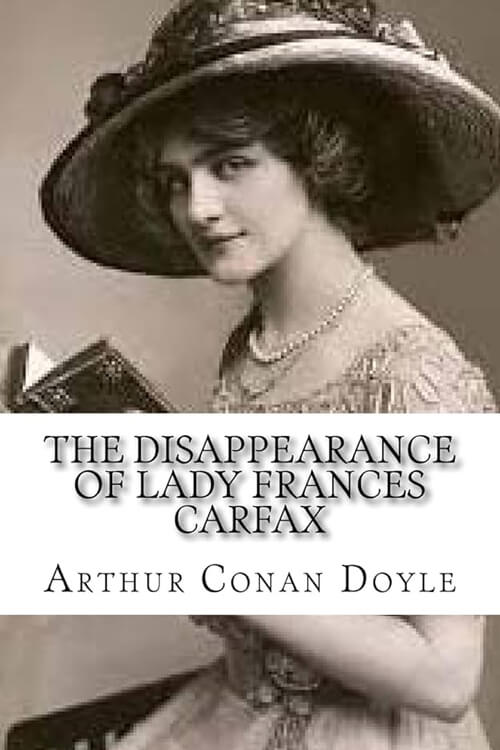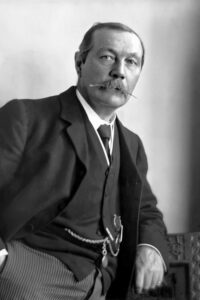
The Disappearance of Lady Frances Carfax
“But why Turkish?” asked Mr. Sherlock Holmes, gazing fixedly at my boots. I was reclining in a cane-backed chair, and my protruded feet had attracted his ever-active attention.
“English,” I answered in some surprise. “I got them at Latimer’s in Oxford Street.”
Holmes smiled with an expression of weary patience.
“The bath!” he said; “the bath! Why the relaxing and expensive Turkish rather than the invigorating homemade article?”
“Because I have been feeling rheumatic and old for the last few days. A Turkish bath is an alternative in medicine—a fresh starting point, a cleanser of the system.
“By the way, Holmes,” I added, “I have no doubt the connection between my boots and a Turkish bath is a perfectly self-evident one to a logical mind, and yet I should be obliged to you if you would indicate it.”
“The train of reasoning is not very obscure, Watson,” said Holmes with a mischievous twinkle. “It belongs to the same elementary class of deduction which I should illustrate if I were to ask you who shared your cab in your drive this morning.”
“I don’t admit that a fresh illustration is an explanation,” said I with some bitterness.
“Bravo, Watson! This is a very dignified and logical remonstrance. Let me see, what were the points? Take the last one first—the cab. You observe that you have some splashes on the left sleeve and shoulder of your coat. Had you sat in the center of a hansom, you would probably have had no splashes, and if you had, they would certainly have been symmetrical. Therefore, it is clear that you sat at the side. Therefore, it is equally clear that you had a companion.”
Read or download Book
Arthur Conan Doyle
Sir Arthur Ignatius Conan Doyle KStJ, DL (22 May 1859 – 7 July 1930) was a British writer and physician. He created the character Sherlock Holmes in 1887 for A Study in Scarlet, the first of four novels and fifty-six short stories about Holmes and Dr. Watson. The Sherlock Holmes stories are milestones in the field of crime fiction.
Doyle was a prolific writer. In addition to Holmes’s stories, his works include fantasy and science fiction stories about Professor Challenger and humorous stories about the Napoleonic soldier Brigadier Gerard, as well as plays, romances, poetry, nonfiction, and historical novels. One of Doyle’s early short stories, “J. Habakuk Jephson’s Statement” (1884), helped popularise the mystery of Mary Celeste.
Name
Doyle is often referred to as “Sir Arthur Conan Doyle” or “Conan Doyle,” implying that “Conan” is part of a compound surname rather than a middle name. His baptism entry in the St Mary’s Cathedral, Edinburgh register gives “Arthur Ignatius Conan” as his given name and “Doyle” as his surname. It also names Michael Conan as his godfather. The British Library and Library of Congress catalogs treat “Doyle” alone as his surname.
Steven Doyle, the publisher of The Baker Street Journal, wrote: “Conan was Arthur’s middle name. Shortly after graduating high school, he began using Conan as a surname. But technically, his last name is ‘Doyle’.” When knighted, he was gazetted as Doyle, not under the compound Conan Doyle.
Doyle’s first novels were The Mystery of Cloomber, which was not published until 1888, and The Unfinished Narrative of John Smith, published only posthumously in 2011. He amassed a portfolio of short stories, including “The Captain of the Pole-Star” and “J. Habakuk Jephson’s Statement,” both inspired by Doyle’s time at sea. The latter popularised the mystery of the Mary Celeste and added fictional details such as that the ship was found in perfect condition (it had taken on the water by the time it was discovered) and that its boats remained on board (the single boat was missing). These fictional details have come to dominate popular accounts of the incident. Doyle’s alternative spelling of the ship’s name, the Marie Celeste, has become more commonly used than the original.
Between 1888 and 1906, Doyle wrote seven historical novels, which he and many critics regarded as his best work. He also wrote nine other books and—later in his career (1912–29)—five narratives (two of novel length) featuring the irascible scientist Professor Challenger. The Challenger stories include his best-known work after the Holmes oeuvre, The Lost World. His historical novels include The White Company and its prequel, Sir Nigel, set in the Middle Ages. He was a prolific author of short stories, including two collections set in Napoleonic times and featuring the French character Brigadier Gerard.
Doyle’s works for the stage include Waterloo, which centers on the reminiscences of an English veteran of the Napoleonic Wars and features a character Gregory Brewster, written for Henry Irving; The House of Temperley, the plot of which reflects his abiding interest in boxing; The Speckled Band, adapted from his earlier short story “The Adventure of the Speckled Band”; and an 1893 collaboration with J. M. Barrie on the libretto of Jane Annie.






